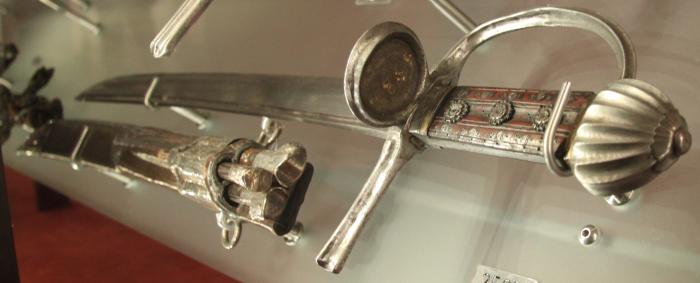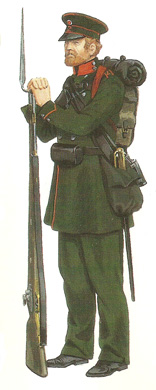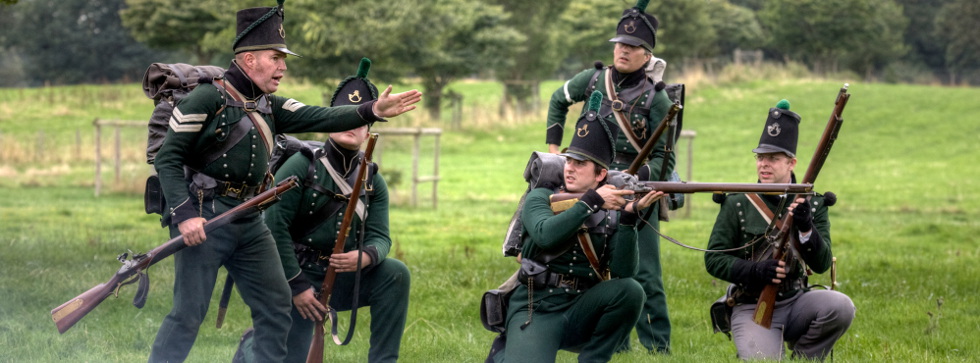| Author |
Message |
|
Niels Just Rasmussen
|
 Posted: Sat 06 Sep, 2014 3:52 am Post subject: Hirschfænger of Danish King Frederik 2 (1559-1588) from 1585 Posted: Sat 06 Sep, 2014 3:52 am Post subject: Hirschfænger of Danish King Frederik 2 (1559-1588) from 1585 |
 |
|
This weapon is from the Rosenborg Castle in Copenhagen. It actually has the name of Frederik 2 and the year 1585 on the grip.
It is said to have been used by the king when doing “perforcejagt“ (German = parforcejagd), where you rode the animal down until it collapsed, and then dismounted to give the killing stroke. [Perforcejagt was made illegal in Denmark in 1777].
I've seen a lot of later hirschfängers with a clam shaped nagel, though this example seems more disc-like.
Im wondering was the Hirschfänger early on basically a normal langes messer (crossguard and nagel), so the nagel was retained through tradition OR does it actually have a purpose when making the coup de grace on a stag?
I haven't been able to figure out when you have the first Hirschfängers, but they have been used basically to modern times.
 Attachment: 24.09 KB Attachment: 24.09 KB

Source: http://dkks.dk/hirschfaenger
|
|
  |
 |
|
Jeffrey Faulk
|
 Posted: Sat 06 Sep, 2014 8:11 am Post subject: Posted: Sat 06 Sep, 2014 8:11 am Post subject: |
 |
|
For a hunting-sword a nagel is purely ornamental. Most animals don't fight back very much, you see! It has some use if one is carrying the hunting sword for self defense, as some people say they originated as...
The origin of hunting swords is pretty vague. Some sources say 12th century, others say 16th or 17th. I lean a little more towards a later date for specialized hunting swords as I imagine that for a long time they probably did not make a huge distinction between hunting swords and regular blades, although they may have had long knives or messer rather than a normal sword. The general line of thought for a later origin (1600's or so) is that as the wars in Europe wound down, life in the cities became much rougher with all the unemployed ex-soldiers (not to mention all the refugees from destroyed countries) so having a weapon for self-defense became a very desirable thing. A small sword turned out to be the ideal thing as it was easier to conceal under a coat. Turned out to be useful for hunting as well. The question is, was it used first for hunting or self defense? That one we'll never be quite sure...
You have been posting some very nice pictures lately, please keep it up 
|
|
  |
 |
|
Niels Just Rasmussen
|
 Posted: Sat 06 Sep, 2014 9:37 am Post subject: Posted: Sat 06 Sep, 2014 9:37 am Post subject: |
 |
|
| Jeffrey Faulk wrote: | For a hunting-sword a nagel is purely ornamental. Most animals don't fight back very much, you see! It has some use if one is carrying the hunting sword for self defense, as some people say they originated as...
The origin of hunting swords is pretty vague. Some sources say 12th century, others say 16th or 17th. I lean a little more towards a later date for specialized hunting swords as I imagine that for a long time they probably did not make a huge distinction between hunting swords and regular blades, although they may have had long knives or messer rather than a normal sword. The general line of thought for a later origin (1600's or so) is that as the wars in Europe wound down, life in the cities became much rougher with all the unemployed ex-soldiers (not to mention all the refugees from destroyed countries) so having a weapon for self-defense became a very desirable thing. A small sword turned out to be the ideal thing as it was easier to conceal under a coat. Turned out to be useful for hunting as well. The question is, was it used first for hunting or self defense? That one we'll never be quite sure...
You have been posting some very nice pictures lately, please keep it up  |
Thanks for your detailed reply. I will keep posting what I find 
To me Frederik 2's hirschfänger looks like a “modernized“ messer for it's time. So if the consensus is around 1600, this 1585 version is a very early one clearly specialized as a hunting weapon. The weapon he carries in this picture below by Hans Knieper is a rapier (with straight crossguards and open ring hilt) and his “knife“ also doesn't seem to have a “messer“ hilt.

So called hirschfänger's was used as military weapons (or more like kept the name, being different style of blades?) by “jäger“-soldiers. Apparently (according to wikipedia) the Landgraf of Hesse was first to make such a company in 1631 comprised of hunters and foresters.
So to side-trek a little bit all military Danish/Norwegian Hirschfängers below are actually military weapons and have nothing to do with hunting.
According to Arma-Dania the first Dano-Norwegian hirschfænger military blade (for artillery) on their list is from 1735, but records show that (likely real hunting) hirschfängers were in use a little before 1720.
[The 1735 one is made by the Main Arsenal in Kristiania (Oslo)]
See: https://www.arma-dania.dk/public/timeline/_AD_blankvaben_view.php?editid1=212
Here we have a Hirschfänger from 1749 for specialized “ski-jægere“ (skiing hunters) in Norway. It's converted from a rapier model 1701. Only 2 still exists today.
https://www.arma-dania.dk/public/timeline/_AD_blankvaben_view.php?editid1=209
The first professional/permanent Danish Jæger-Corps is from 1785.
Found here a nice example of a military Jæger-Hirschfänger model 1791 (actually a converted 1750 cavalry sword):
https://www.arma-dania.dk/public/timeline/_AD_blankvaben_view.php?editid1=69
The military versions are a lot longer (60-76 cm) than true hunting hirschfängers I would reckon.
Apparently the Dano-Norwegian artillery Hirschfängers are without lionhilts and the Jæger-ones from the Napolionic era are with lionhilts.
Last one issued is from 1849. From now on it's mostly sabers.
|
|
  |
 |
|
Jeffrey Faulk
|
 Posted: Sat 06 Sep, 2014 10:43 am Post subject: Posted: Sat 06 Sep, 2014 10:43 am Post subject: |
 |
|
It is quite common after about the late 1600's or early 1700's for soldiers to be issued swords, very many with brass hilts. The best known is probably the French briquet or cabbage-chopper from the Napoleonic era, but there were very many types issued. These probably saw much more use chopping firewood, butchering meat or being polished bright to look nice with a uniform than actual fighting, though. The military hirschfanger you show are absolutely typical of this kind of use.
That is largely due to the growth of organized fire-arm use in a military context from the 1600's onward. By the start of the 1700's nearly all armies were entirely firearm equipped; the only exceptions were cavalry, which used swords largely because it was difficult for them to re-load on horseback.
I am not familiar with European companies of hunter-soldiers, but it strikes me as an artifact of nobility and European customs where the high families considered hunting to be their sport, versus the Americas where anybody can go out and hunt in the forest.
|
|
  |
 |
|
Niels Just Rasmussen
|
 Posted: Sat 06 Sep, 2014 11:15 am Post subject: Posted: Sat 06 Sep, 2014 11:15 am Post subject: |
 |
|
| Jeffrey Faulk wrote: | It is quite common after about the late 1600's or early 1700's for soldiers to be issued swords, very many with brass hilts. The best known is probably the French briquet or cabbage-chopper from the Napoleonic era, but there were very many types issued. These probably saw much more use chopping firewood, butchering meat or being polished bright to look nice with a uniform than actual fighting, though. The military hirschfanger you show are absolutely typical of this kind of use.
That is largely due to the growth of organized fire-arm use in a military context from the 1600's onward. By the start of the 1700's nearly all armies were entirely firearm equipped; the only exceptions were cavalry, which used swords largely because it was difficult for them to re-load on horseback.
I am not familiar with European companies of hunter-soldiers, but it strikes me as an artifact of nobility and European customs where the high families considered hunting to be their sport, versus the Americas where anybody can go out and hunt in the forest. |
So even military hirschfängers still had mostly a utilitarian use. So truly an all purpose tool.
The jæger-soldiers was comprised not of noblemen (but most likely lead by one), but by foresters (Danish “Skovrider“) that was originally hired to look after the kings/noblesmens forests and hunters (Danish: Livjæger) that caught meat for dinners/feasts.
Jægere were often used in reconnaissance and skirmishes as snipers.
The Hessian & Ansbach Jägers fought for the English in the American Revolutionary war ! Here is a link to the Hessian Companie von Roeder : http://www.jagercompanie.com/Historical_Unit.html
It seems that later Danish Jæger units from the Napoleonic Wars were taken from either students [Kronprinsens Livkorps, later Kongens Livkorps, 1801-1864] or middle-upper class citizens [Kongens Livjægerkorps, 1801-1870], and not people with a hunting background. Uniforms still green though.
They both fought the English in the Battle of Copenhagen in 1807 [Kronprinsens Livkorps 900 men and Kongens Livjægerkorps 400 men, whereas 100 of them (1 of the 4 companies) were the so called “Herregårdsskytterne“ (created 1807) being “real“ Jägers“].

Source: http://vaeggen.copenhagen.dk/media/937
Danish soldier from Kongens Livjægerkorps from the Napoleonic Wars 1807. I have this print myself!!! 

Source: http://www.familien-jonesen.dk/Jens%20Jensen%20og%20Kirsten.html
Danish Jæger from the 1. Slesvig War 1848-50.
Green uniform with a rifle and a hirschfänger.
Last edited by Niels Just Rasmussen on Thu 11 Sep, 2014 8:51 am; edited 2 times in total
|
|
  |
 |
J. Nicolaysen

|
 Posted: Sun 07 Sep, 2014 1:56 am Post subject: Posted: Sun 07 Sep, 2014 1:56 am Post subject: |
 |
|
Ja bringe på de danske billeder!
Or something like that. The by-knives in the first picture looked interesting also. Have you found any hunting swords with antler hilts?
|
|
  |
 |
|
Niels Just Rasmussen
|
 Posted: Sun 07 Sep, 2014 6:27 am Post subject: Posted: Sun 07 Sep, 2014 6:27 am Post subject: |
 |
|
| J. Nicolaysen wrote: | Ja bringe på de danske billeder!
Or something like that. The by-knives in the first picture looked interesting also. Have you found any hunting swords with antler hilts? |
Not quite like that, but easily understandable. I'll try to bring more pictures when I find them  . .
All the Danish military issued Hirschfängers didn't have antler hilts. But I can easily find some German ones on the net with antler hilts.
With the by-knives (those placed outside the scabbard) I actually didn't pay attention to it before you asked. Actually pretty interesting. Anyone out there an expert on by-knives?
To continue the story about Jæger soldiers in the Danish Army. As all this military unit stuff is extremely complicated because of constant shuffling I might have made some mistakes  . .
In 1784 the 16 year old King Frederik 6 came to power and feared attacks from the Swedish King Gustav 3. Having seen the way the Americans had fought in The Revolutionary War he decided to create some Jæger-companies each with 100 men + NCO and officers.
The first two was “Sjællandske Jægerkorps“ (1785-1842) and “Holstenske Jægerkorps“ (1785-1788, from 1789 send to Norway and becomes “Norske Jægerkorps“, and then to fill the hole “Feltjægerkorpset“ (1790-1808) was created instead). Shortly afterwards “Slesvigske Jægerkorps“ (1788-1842) was created.
With the first English Attack in 1801 you got “Kongens Livjægerkorps“ (1801-1870) of volunteers and so not professionel hunters.
At the English attack in 1807 some Cavalry-Jæger units were created:
The volunteer “Herregårdsskytterne“ (1807) became after the English victory “Sjællandske Ridende Jægerkorps“ (1807-1814), also created was “Fynske Ridende Jægerkorps“ (1807-1814), “Jydske Ridende Jægerkorps“ (1807-1814) & “Langelandske Ridende Jægerkorps“ (1808-1816).
Then some sharpshooter units: “Sjællandske Skarpskyderkorps“ (1808-1816, then afterwards “Jydske Jægerkorps“ 1816-1842)) and “Holstenske Skarpskyttekorps“ (1808-1816, then “Holstenske Jægerkorps“ (1816-1820), then “Launborgske Jægerkorps“ (1820-1842)).
In 1842 the army was reshuffled:
“1. Jægerkorps“ was created.
Sjællandske Jægerkorps became “2. Jægerkorps“ (1842-1860)
Jydske Jægerkorps became “3. Jægerkorps“. (1842-1860)
Slesvigske Jægerkorps became “4. Jægerkorps“ (1842-1848, recreated 1852-1860)
Launborgske Jægerkorps became “5. Jægerkorps“ (1842-1848, then recreated in 1851 as “Holstenske Jægerbataljon“ and as “5. Jægerkorps“ (again) from 1852-1860.
Then from the 1. Slesvig War you have “Lauenborgske Jægerbataljon“ (1848-1851)
In 1860 most of the Jæger-companies apparently became a part of Regular Infantry Units as scouts/sharpshooters.
The current Danish “Jægerkorpset“ from 1961 marks it descent from Sjællandske Jægerkorps (1785) & 2.Jægerkorps (1842).
OK I probably forgot some....now to find pictures or some info on weaponry.
Last edited by Niels Just Rasmussen on Sun 07 Sep, 2014 8:20 am; edited 1 time in total
|
|
  |
 |
|
Niels Just Rasmussen
|
|
  |
 |
J. Nicolaysen

|
 Posted: Sun 07 Sep, 2014 7:35 am Post subject: Posted: Sun 07 Sep, 2014 7:35 am Post subject: |
 |
|
| Quote: | | Not quite like that, but easily understandable. I'll try to bring more pictures when I find them Big Grin |
It has been a couple of generations since my family spoke Dansk, but we have family still there and trade visit sometimes. 
By all means please post any pictures of Danish or German hunting style swords in a thread here if you will http://www.myArmoury.com/talk/viewtopic.php?t...ght=antler
There is a German Hirschfanger on the second page. I am thinking of a project like that or another posted later, long knife with by-knives.
This is an interesting thread about danish weapons a little later than my interests, but it is very nice to see anyhow, thank you. The Jaegers are interesting soldiers certainly.
|
|
  |
 |
|
Niels Just Rasmussen
|
 Posted: Sun 07 Sep, 2014 9:09 am Post subject: Posted: Sun 07 Sep, 2014 9:09 am Post subject: |
 |
|
| J. Nicolaysen wrote: | | Quote: | | Not quite like that, but easily understandable. I'll try to bring more pictures when I find them Big Grin |
It has been a couple of generations since my family spoke Dansk, but we have family still there and trade visit sometimes. 
By all means please post any pictures of Danish or German hunting style swords in a thread here if you will http://www.myArmoury.com/talk/viewtopic.php?t...ght=antler
There is a German Hirschfanger on the second page. I am thinking of a project like that or another posted later, long knife with by-knives.
This is an interesting thread about danish weapons a little later than my interests, but it is very nice to see anyhow, thank you. The Jaegers are interesting soldiers certainly. |
So as Danish descendent I can show you the British Jaeger-opposition, that destroyed Denmark as military and especially naval power in 1807.
The British had also created “jaegers“ (learning from the American Revolutionary War) and send 5 companies to Denmark in 1807. The 95th Regiment of Foot (Rifles), [from 1816 called “The Rifle Brigade“].
One of the first - if not the first - British troops in camouflage green.
In the Battle of Køge 1807 the British and Hanoverian forces destroyed the quickly assembled Danish Rural Militia trying to relieve the besieged capital [no wonder, battle hardened troops against peasants in an almost 1:1 fight] and the 95th was there probably used as skirmishers/sharpshooters. The British forces at the Køge battle was lead by General Arthur Wellesley (later Field Marshal & Duke of Wellington). Basically all the Danish forces was in Holsten [26.000] to prevent a French attack [at that time Denmark had border with Napoleon and he had a lot of troops there] with only a few in Copenhagen.
The British never declared Denmark/Norway war, but landed north of Copenhagen with 15.000 troops after ships giving friendship salutes when sailing through Øresund and Kronborg Castle at Elsinore. They attacked the city using rockets (designed by William Congreve) until the Danes were forced to capitulate and the entire navy was taken - and there were still no war declaration. The entire Danish Navy has been grounded well before the battle, because of British political pressure (fear of Denmark's navy joining Napoleon), but the British government didn't believe it, though it was true. So the Danes had no way to get any real troops to help the besieged capital, hence the desperation of the militia army marching on the British.

Reenactors of 95th Regiment of foot.
Source: http://www.95th-rifles.co.uk/files/4513/5464/...Banner.JPG

Reenactors of 95'th Regiment of foot.
Source: http://www.1st95thrifles.com/images/photos/20...%20002.jpg
Weaponry was a Baker Rifle:
Source: http://www.95th-rifles.co.uk/equipment/baker-rifle/
Bayonet was a 1801 Sword bayonet (also a huge blade like the hirschfænger-bayonet used by Norwegian ski-løbere):
Source: http://www.95th-rifles.co.uk/equipment/sword-bayonet/
Officer sabers: [in the British army I think most soldiers had to buy it themselves?].
Pattern 1803 Light Infantry Sabre were carried by some officers.
Source: http://www.95th-rifles.co.uk/equipment/officers-swords/
|
|
  |
 |
|
|
You cannot post new topics in this forum
You cannot reply to topics in this forum
You cannot edit your posts in this forum
You cannot delete your posts in this forum
You cannot vote in polls in this forum
You cannot attach files in this forum
You can download files in this forum
|
All contents © Copyright 2003-2025 myArmoury.com — All rights reserved
Discussion forums powered by phpBB © The phpBB Group
Switch to the Basic Low-bandwidth Version of the forum
|

